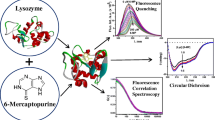Abstract
The characteristic binding mode of zinc(II) complexes of macrocyclic tetraamines (1,4,7,10-tetraazacyclododecane, cyclen) appended with one or two arylmethyl group(s) [(4-quinolyl)methyl-, 1,7-bis(4-quinolyl)methyl-, (1-naphthyl)methyl-, 1,7-bis(1-naphthyl)methyl-, and (9-acridinyl)methyl-cyclen] to double-stranded calf thymus DNA and synthetic DNAs [poly(dA)·poly(dT), poly(dA-dT)2, poly(dI)·poly(dC), poly(dI-dC)2, poly(dG)·poly(dC), and poly(dG-dC)2] has been examined by spectrophotometric methods, T m measurement, and inhibition of these DNA-directed transcriptions in vitro. Various hypochromic and bathochromic effects on the pendant aromatic absorption spectra of the complexes were observed in titration with the native and synthetic DNA. The binding constants K app (=[bound cyclen derivatives]/[unbound cyclen derivatives][DNA phosphates] M–1), at 25 °C in 10 mM EPPS (pH 8.0) containing 0.1 M Na+, were determined and compared with those of the corresponding Zn2+-free ligands. The results showed that the Zn2+-cyclen complexes interact with the DNA more strongly than the corresponding diprotonated ligands, leading to a stronger stacking of the pendant aromatic rings. The binding of Zn2+–(9-acridinyl)methyl-cyclen to calf thymus DNA was competed by an AT-selective, minor groove binder, distamycin, but not by a major groove binder, methyl green. In an unusual interaction of excess Zn2+–(9-acridinyl)methyl-cyclen with poly(dA)·poly(dT), the Zn2+-cyclen moiety went into the minor groove to make coordination bonds with the deprotonated imides of the thymines, resulting in disruption of the poly(dA)·poly(dT) duplex. Thymine-containing DNA-directed transcription with Escherichia coli RNA polymerase in vitro was inhibited by the Zn2+–(9-acridinyl)methyl-cyclen. The 50% inhibition concentrations of the transcription (IC50) were 22–45 μM with poly(dA)·poly(dT) or poly(dA-dT)2 as templates, while with poly(dG-dC)2 as a template the IC50 value was 110 μM.
Similar content being viewed by others
Author information
Authors and Affiliations
Additional information
Received: 15 February 1999 / Accepted: 22 April 1999
Rights and permissions
About this article
Cite this article
Kikuta, E., Katsube, N. & Kimura, E. Natural and synthetic double-stranded DNA binding studies of macrocyclic tetraamine zinc(II) complexes appended with polyaromatic groups. JBIC 4, 431–440 (1999). https://doi.org/10.1007/s007750050329
Issue Date:
DOI: https://doi.org/10.1007/s007750050329




